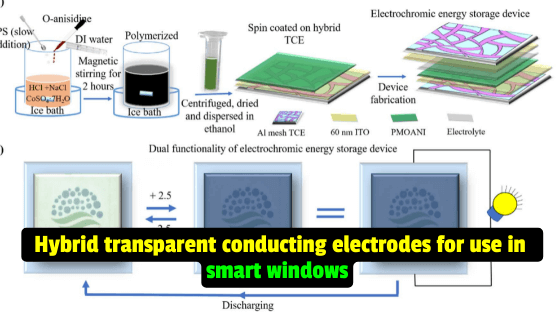A team of Indian scientists from the Centre for Nano and Soft Matter Sciences (CeNS) and Jawaharlal Nehru Centre for Advanced and Scientific Research (JNCASR) have developed a cost-effective polymeric electrochromic smart window that can store energy using hybrid transparent electrodes.
Bullet Point Summary:
- Utilizes a chemically synthesized conducting polymer, poly(o-methoxyaniline)
- Hybrid transparent electrode made of ITO-60 nm/Al-mesh
- Rapid switching ability and can perform several transparency switches as well as charging/discharging cycle
- Shows dual functionality by switching colour and powering small electronic devices
- Semi-automated production plant set up for the production of hybrid transparent conducting electrodes
Traditional smart windows, made of Tin doped Indium oxide (ITO), are expensive and have limited market uptake. The scientists used a chemically synthesized conducting polymer, poly(o-methoxyaniline), as an electrochromic layer over a low-cost transparent conducting electrode to form the smart window. The hybrid transparent electrode, made of ITO-60 nm/Al-mesh, significantly reduced the cost of the device without sacrificing performance. The device can switch from transparent to dark blue and vice versa on the application of nominal voltage and can power small electronic devices with energy stored during the dark blue state. The scientists have set up a semi-automated production plant to produce hybrid transparent conducting electrodes for smart window applications.
Outcomes:
- Indian scientists have developed a cost-effective polymeric electrochromic smart window.
- The window can store energy using hybrid transparent electrodes and can switch the transparency.
- The technology can potentially replace traditional, costly smart windows in modern structures.
Fabrication of dual-functional electrochromic smart window based on a low-cost hybrid transparent electrode coated with a solution-processable polymer
Karumuthil; Ganesha; Mondal; Singh; Kulkarni
Full-text link: https://doi.org/10.1039/d2ta05973h
What this paper is about
- However, the process complexity, low stability, high sheet resistance, inhomogeneous electric eld distribution and low transparency limit their application in EC smart window fabrication.
- Recently, self-formed crackle template-based metal mesh TCEs have emerged as a potential replacement for their counterparts due to their affordability, scalability, high stability and excellent optoelectronic properties.
- The EC material, PMOANI, is synthesized using oxidative chemical polymerization and characterized for its electrochromic properties.
What you can learn
- Briey, the electrochromic polymer poly, synthesized by the oxidative chemical polymerization of o-methoxyaniline in an acidic medium, was spin-coated on an optimized hybrid TCE and integrated with another hybrid electrode by sandwiching an electrolyte for device fabrication.
- To obtain the optimal thickness of PMOANI lms for the best electrochromism, spectroelectrochemical studies were performed on samples in a three-electrode electrochemical cell with LiClO 4 in PC as the electrolyte.
- The transmittance spectra and transmittance modulation of the EC material/ITO samples in different spin coating recipes are shown in and c. DT values at 700 nm indicate that, at higher rpm, the samples exhibit lower DT, which can be ascribed to the inadequate lm thickness at higher rpm.
- shows the transmittance spectra of the device, which shows DT $57% between coloured and bleached states.
- The PMOANI-coated hybrid TCE displays excellent electrochromic performance with a high transparency modulation of 55%, fast switching speed and cycling stability along with energy storing ability.
- A two-terminal device is demonstrated to power a timer display for more than 20 min by storing its energy in the coloured state, showing the dual functionality of the EES device.
Q: What is an electrochromic smart window?
A: An electrochromic smart window is a type of window that can change its transparency and store energy using hybrid transparent electrodes.
Q: Why have traditional electrochromic smart windows had limited market uptake?
A: Traditional electrochromic smart windows have had limited market uptake due to the high processing and material costs, particularly those made of Tin doped Indium oxide (ITO).
Q: What solution have Indian scientists found for making electrochromic smart windows more cost-effective?
A: Indian scientists have found a cost-effective solution by using a chemically synthesized conducting polymer as an electrochromic layer on a low-cost transparent conducting electrode.
Q: What is the hybrid electrode used in the cost-effective electrochromic smart window?
A: The hybrid electrode is a transparent conducting electrode that uses a reduced amount of ITO (60nm) instead of the traditional 280nm without compromising its performance.
Q: What is the potential use of the low-cost hybrid transparent conducting electrodes?
A: The low-cost hybrid transparent conducting electrodes have enormous potential to be used in advanced large-area smart window applications.
Q: What have Indian scientists developed as a cost-effective alternative to traditional smart windows?
A: Indian scientists have developed a cost-effective polymeric electrochromic smart window that can store energy using hybrid transparent electrodes and carry out transparency switching.
Q: Why have traditional smart windows not been widely used in modern structures?
A: The high processing and material costs of traditional smart windows, especially those made of Tin doped Indium oxide (ITO), have resulted in limited market uptake.
Q: How did the Indian scientists make their smart window cost-effective?
A: The scientists found a cost-effective solution by utilizing a chemically synthesized conducting polymer, poly(o-methoxyaniline) (PMOANI), as an electrochromic layer over a low-cost transparent conducting electrode (ITO–60 nm/Al-mesh) to form a smart window. They also used the concept of the hybrid electrode, where the required ITO thickness is brought down to 60 nm from 280 nm without compromising its performance.
Q: What are the capabilities of the new smart window developed by Indian scientists?
A: The electrochromic device exhibited an excellent optical contrast of 57% between colored and transparent states. It has a rapid switching ability and can perform several transparency switches as well as the charging/discharging cycle (energy storage) without any degradation in the device’s performance. It can also power small electronic gadgets using the energy stored in the “dark blue” state.
Q: What plans are for producing the hybrid transparent conducting electrodes used in the smart window?
A: The scientists have set up a semi-automated production plant to produce hybrid transparent conducting electrodes (TCE) for smart window applications. These transparent conducting electrodes can be made available to interested industries and R&D labs on a request basis to explore collaborative projects.




